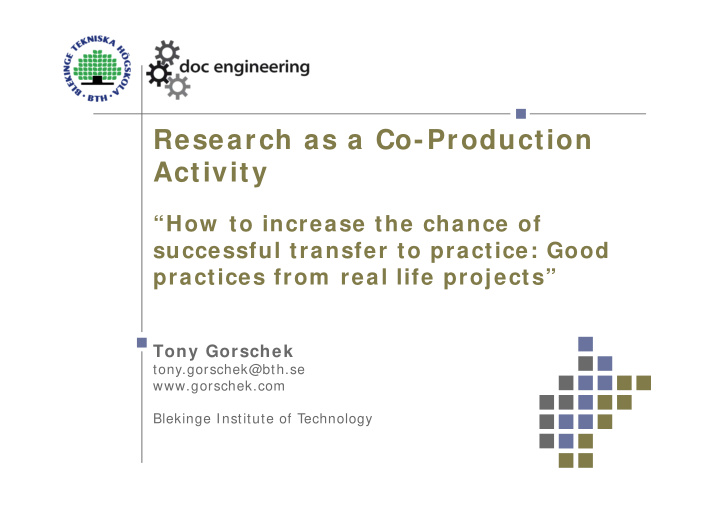



Research as a Co-Production Activity “How to increase the chance of successful transfer to practice: Good practices from real life projects” Tony Gorschek tony.gorschek@bth.se www.gorschek.com Blekinge Institute of Technology
disposition… Basic concepts, the big picture Assessment – basing research on industry challenges Formulating the problem / motivation / related work Candidate solution(s) VALIDATION AND TT Case Examples End Results Lessons Learnt
background/ introduction (Tony Gorschek) Engineer / Problem Solver / Researcher – Professor, PhD (Tekn. Dr.) Software Engineering, M.Sc. CS., B.Sc. Business Administration – 10+ years in industry (5 start-ups, CTO, Senior Executive Consultant, Chief Architect, Technical Advisor) – 9 years as a researcher • Technology Product Management, Requirements Engineering, Quality Assurance, Process Assessment and Improvement, Innovation • Founder International Software Product Management Association (ispma.org) • Board member: Swedish Requirements Engineering Network (SIREN), Swedish Association for Requirements Engineering (SARE) • LEAN (REAL LEAN)
the big picture… Why are we doing research? “Science” and “Engineering” Useful (does it do its job?) Usable (is it viable to use it?) - Scalability - ROI, TTROI - Best alternative investment Financing (Swedish System) Quid-pro-quo Industry impact … a simple model for co-production (tech transfer)
not so uncommon research approach… ? ? empirical data peer recognition publish
research approach Dynamic Validation Static Validation Problem Formulation Study Validation State-of- in the-art academia
research approach Dynamic Validation Static Validation Problem Formulation Study Validation State-of- in the-art academia
step 1… Figuring out what to research Needs/possibilities for improvement in industry! - Assessment (use e.g. iFLAP, CMMI, SPICE, other..) - Concrete points that can be investigated… - NOT consultancy! “Low-hanging fruit” is not your goal… - Multiple sources (selection criteria is paramount) SUPPORT from all types of practitioners - Official vs. actual processes… - Is it a problem or not? List of “possibilities for improvement” - Prioritize the list (see iFLAP or DAIIPS) Starting point for step 2
research approach Dynamic Validation Static Validation Problem Formulation Study Validation State-of- in the-art academia
step 2… Problem formulation What is the problem(s) 0. is it relevant for the company at hand 1. is it relevant for research (academic point of view) 2. is it relevant for industry in general? GENERALIZABILITY.. 3. RELATED WORK (the wheel has been invented, don’t do it twice) 4. Symptom vs. Actual “problem” - Iterate ideas/concepts and discuss with your industry partners (get ideas, feedback and make sure your not going totally off target) - “a solution” is easier to sell/get backing of than a problem… Starting point for step 3
research approach Dynamic Validation Static Validation Problem Formulation Study Validation State-of- in the-art academia
step 3… Candidate solution(s) formulation A model, a practice, a process, a method, a framework, a technology, a “whateveryouthinkisthesolution” - in cooperation with industry partners (they will and should keep it REAL, the researcher is the catalyst and potential source of innovation and should be skilled in the technologies (RELATED WORK)) - candidate solutions need to be formulated properly with supporting materials (plan for validation, e.g. metrics, qualitative study etc) so that they can be “tested” i.e. VALIDATED - generalizability - based on the “problem”, can you find more cases (companies)? Starting point for step 4 (5,6..)
research approach Dynamic Validation Static Validation Problem Formulation Study Validation State-of- in the-art academia
step 4… Validation in academia (first step of validation) Why not in industry directly at this stage? - Risk minization - Proof of concept (dismissal?!) - Avoid initial problems presenting in industry (scalability, usefulness, usability etc…) - Base for “sales” (big part!), collecting “evidence”! - TECH: Experiments, Workshops, Seniors, test on “toy examples” etc (iterations) ----- dismiss/refine/add/change based on results ----- Starting point for step 5 (6..)
research approach Dynamic Validation Static Validation Problem Formulation Study Validation State-of- in the-art academia
step 5… Static validation - walk before you run! - you have already been working/collaborating w. industry (during all previous steps…) but now you scale it up! - getting feedback on your solution from the ones that gave you the problem to begin with (same people ++ as in the assessment) – SUPPORT from all practitioners TECH: Workshops, presentations, work sessions, experiments (hard and costly), interviews, questionnaires etc - Base for SALES (again) – RELATIVE VALUE + RISK MITIGATION REFINE + Develop materials for piloting + making sure resources are available etc… Starting point for step 6
research approach Dynamic Validation Static Validation Problem Formulation Study Validation State-of- in the-art academia
step 6 (7)… Dynamic validation - as your “solution” is poked, prodded, changed, fixed, scaled down etc.… it is: A. refined / adapted for industry use B. trust is built (risk mitigation, sales of relative value etc.) (this has always been in motion as you have done assessment and presented the solution in static validation to the practitioners…) if you are lucky and work very very hard… you may get the chance to pilot your solution in industry - Preparation (tailoring… + materials + support + champion training + tool support etc) - How do you measure the results? (metrics, expert opinion etc) ==> Action Research vs. Actual Piloting ---
general experience Consultant vs. Researcher twice the work = (half the pay + half the publications) YES (but) industry relevant, producing something that is actually used Validity - try to have multiple case (generalizability) - think about your influence/impact (indirect transfer…) - confounding factors! (evaluation/measurement) - if you ask them to give you a bucket, you will probably get a bucket… Measures - very hard in industry (but that is not an excuse!) - expert opinion (what is it worth?!)
general experience Thoughts understanding goes both ways researchers working in collaboration with industry have two masters... collaboration is a continuous activity process change and introduction of new “solutions” take time and is not for free treat your process improvement as a product development instance... politics is hard... one size does not fit all project focus is ultimately inadequate and short sighted start with low-hanging fruit
Recommend
More recommend